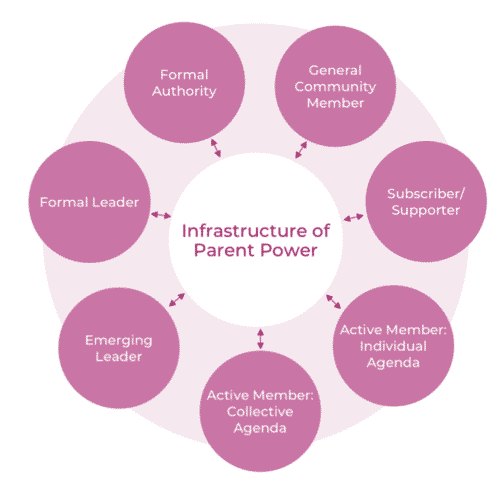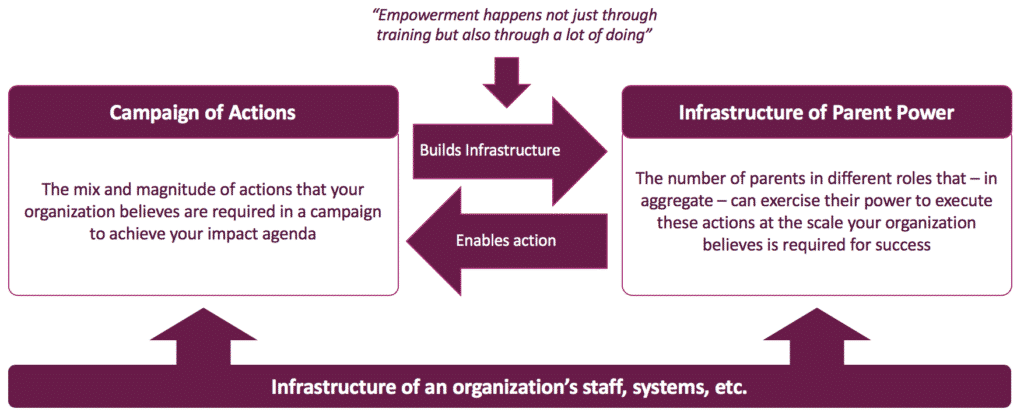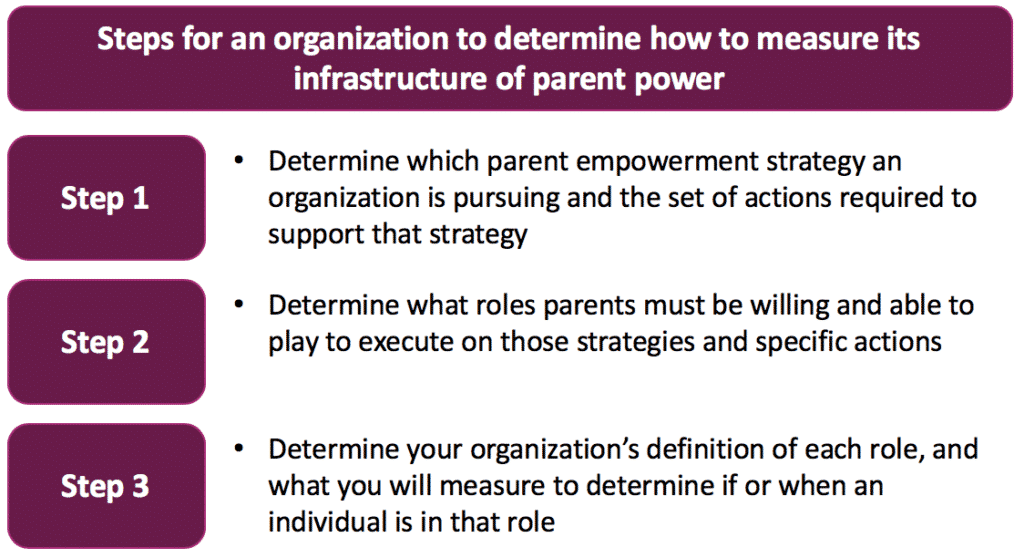MEASURING INFRASTRUCTURE
In addition to inputs, outputs and outcomes, parent empowerment efforts include a fourth essential category of measurement – infrastructure.

Parents can exercise their power across a range of roles. Each of these roles is different, but all create value. Organizations can quantify parent power by measuring the number of parents they have relationships with in each of these roles.
Some organizations do this informally. Others measure the infrastructure of parent power based solely on specific actions, such as phone banking or public actions (for more on these measures, see the tabs on individual actions).
Still other organizations explicitly define a set of parent roles, and then invest in developing the number of parents in those roles necessary to succeed in a campaign (and ultimately across multiple campaigns).
An infrastructure of parent power is not built overnight, nor is it a one-time occurrence. Infrastructure is about relationships between an organization and the parents they serve, and what parents decide they will do - individually and/or collectively - as a consequence of this relationship.
As such, building infrastructure involves continual engagement with individuals to: (a) Build and sustain relationships; (b) understand their needs as parents and their priorities for their children and community; and (c) co-create compelling impact agendas that parents are willing to devote their scarce time and energy to support.
“Because time is such a precious resource for both our staff and our parent partners, when we start to think about any campaign, we need to have a quick and accurate sense of which parents will be interested in an agenda based on our relationship with them, what we know about what they care about, and what they have been active on in the past,” shares Jonathan Klein, Founder and CEO of GO Public Schools. "This early agenda-setting HAS to happen closely with parents - we aren’t going to succeed at taking on an issue if there isn’t that critical mass of parent leaders and active members to partner with us, and - if need be - help us build out a larger infrastructure to enable a campaign to succeed.”
How infrastructure and actions interact
In the 1980’s movie, Top Gun, an officer cautions Tom Cruise’s character, “your ego is writing checks your body can’t cash.” This is a risk many nonprofits also face – our aspirations can outstrip our abilities.
When an organization in the parent empowerment space is developing its campaign plan, it must think not only about the actions (trainings/workshops, house-meetings, public actions, phone-banking, etc.) it feels are necessary to accomplish that campaign’s impact agenda, but also about the infrastructure of parent power required to execute on these actions.

Part of the complexity in this lies in the interaction between actions and infrastructure. Infrastructure is required to enable the execution of actions. But actions themselves can also develop this infrastructure of power. Sierra Jenkins, Vice President of Research, Policy and Communications at Innovate Public Schools, notes that, “empowerment happens not just through training but also through a lot of doing.”
Actions and infrastructure must reconcile in order for a campaign of any type to succeed, which is why measurement and target-setting are so important. To use the example of canvassing: an organization wants to reach 1,500 people through canvassing, which could require knocking on up to 6,000 doors. This organization expects an active member to knock on an average of 100 doors over the course of a campaign. The organization, therefore, needs a minimum of 60 active, trained members who show up to canvass. Further, knowing that not everyone who signs up shows up, an organization may need 80 parents who sign up to canvass. Even further, knowing that not everybody who is trained even signs up to participate, the organization may need to train as many as 100 parents on canvassing to get 60 active canvassers. In addition, the organization may need 10 parents serving as formal leaders who know how to organize and lead canvassing sessions. The fewer the number of active members and leaders, the more an organization is asking of each of them (which may not be reasonable), or the less the organization can accomplish in this action. The infrastructure available becomes either a limiter or an enabler on the ability to execute an action.
Fortunately, the infrastructure of parent power can be built. If an organization’s existing infrastructure is insufficient for an action like canvassing, it can invest in other actions, such as workshops and trainings, to build that infrastructure. It may need to recruit more subscriber/supporters to become active members on a collective agenda or reach out and make the ask of active members focused on an individual agenda to become partners in a collective agenda. Parents taking action builds the skills and will of many of those parents to take further actions – which further builds the collective infrastructure of that community and organization.
Unfortunately, the infrastructure of parent power can also dissipate. Infrastructure is built on relationships, and like any relationships, sustaining infrastructure requires constant investment and renewal. Organizations have to continually provide value to parents on the priorities most important to them, which means asking and listening to determine what those priorities are. The easiest way for relationships to deteriorate is when setting the agenda becomes one-sided, with organizations setting the agenda FOR parents instead of working together to ensure the agenda is set BY parents and organizations together.
How organizations actually quantify each of these roles
 Some roles are easier to quantify than others. And we want to emphasize again that not every organization seeks to develop the power of parents in all of these roles. The required infrastructure of parent power, and therefore the roles parents play, can vary based on (1) which of the four parent empowerment strategies an organization focuses on (and the underlying actions), which then (2) determines which roles parents must play to execute on those strategies. Organizations will then (3) determine the definition of each of their roles, which drives measurement.
Some roles are easier to quantify than others. And we want to emphasize again that not every organization seeks to develop the power of parents in all of these roles. The required infrastructure of parent power, and therefore the roles parents play, can vary based on (1) which of the four parent empowerment strategies an organization focuses on (and the underlying actions), which then (2) determines which roles parents must play to execute on those strategies. Organizations will then (3) determine the definition of each of their roles, which drives measurement.
Organizations may also have their own language for how they think about different parent roles. We believe these seven archetypes capture the range of parent roles, but we recognize that each organization may use different internal language/designations.
Further, not every organization uses the same measures to define the same roles. One organization may define a “Supporter/Subscriber” based on a measure that another uses to set the bar for an “Active Member.” Particular variability exists around different levels of leadership.
Ultimately, each organization needs to decide for itself what roles are included in its infrastructure of parent power and what measures go into the definition of each role. Also, to acknowledge the complexity (and perhaps irony) in measuring infrastructure, infrastructure is usually defined by a set of output and outcome measures (see below).
Here are the most common measures tracked to quantify an infrastructure of parent power in each of these seven roles:
General Community Member
An individual who is consuming value from your organization (i.e., going to your website or social media) or receiving mass outreach from you (i.e., mass mailing, mass emailing, advertising), but for whom you don’t have unique identifying information.
Subscriber/Supporter
An individual who is known to your organization with unique identifying information (which also allows you to segment by attributes).
A subscriber/supporter is a consumer of your organization’s resources (in ways that often can be measured) but is not actively engaged at a personal level in taking action in a way you can track.
Active Member: Individual Agenda
A parent who is actively exercising their power through your organization with the focus being on meeting the needs of their children (versus a larger collective agenda).
Active Member: Collective Agenda
A parent who is actively exercising their power through your organization on an issue or electoral campaign at the school, district, city, state or even federal level. This could include participating in one or more actions (e.g. house meetings, public actions or canvassing) both online and in the real world.
Formal Leader
A parent who sees themselves and is seen by others as a leader, can plan and execute collective action, and is followed by members of their community.
Formal Authority
A parent who holds a formal role in the system – elected, appointed or employed – to have influence on decisions impacting their community.

225 Franklin Street, Suite 350
Boston, MA 02110
617.912.8800
This work is licensed under a Creative Commons Attribution-NonCommercial-ShareAlike 2.0 License (CC BY-NC-SA 2.0)
Click Here to learn more.
